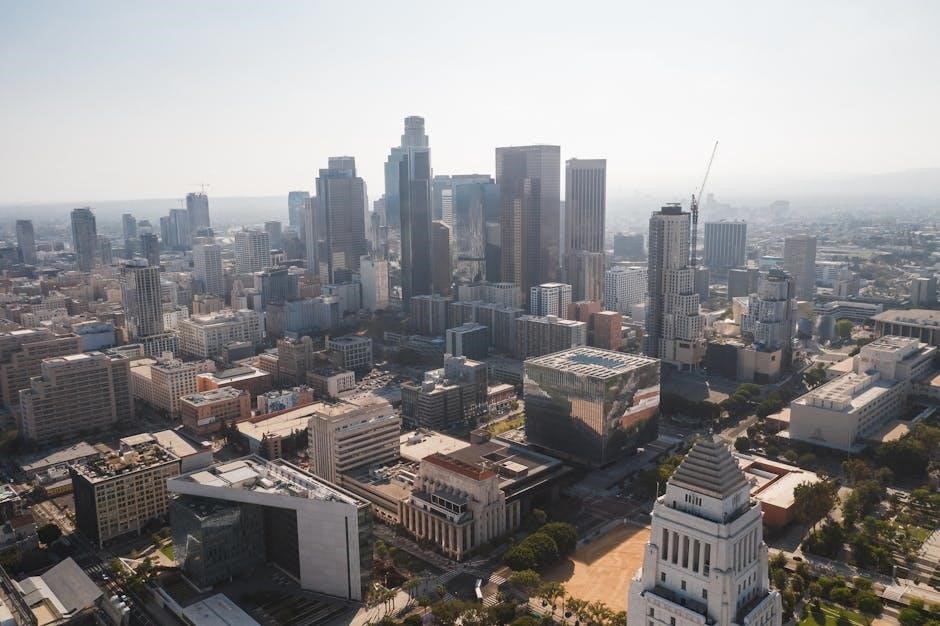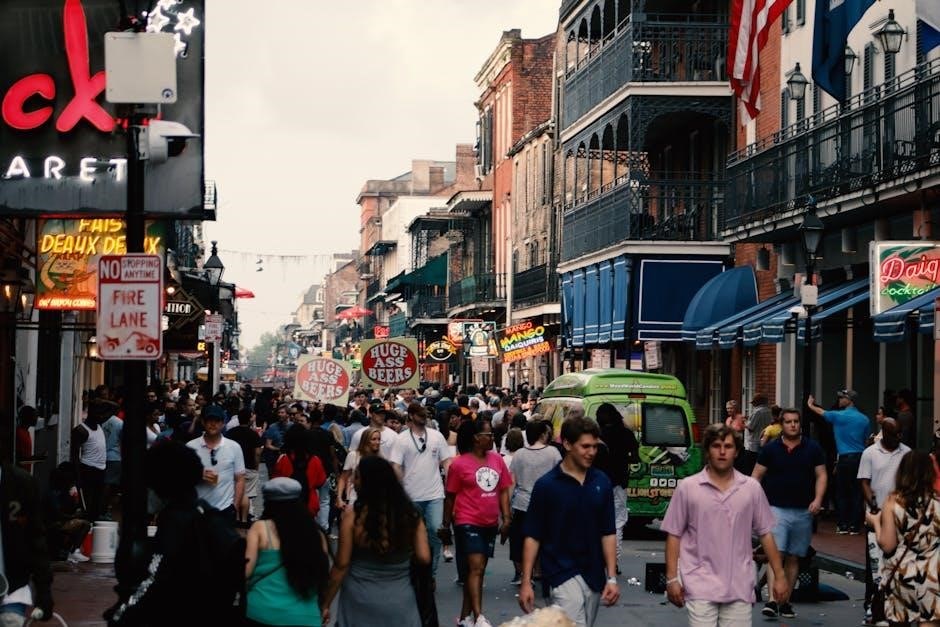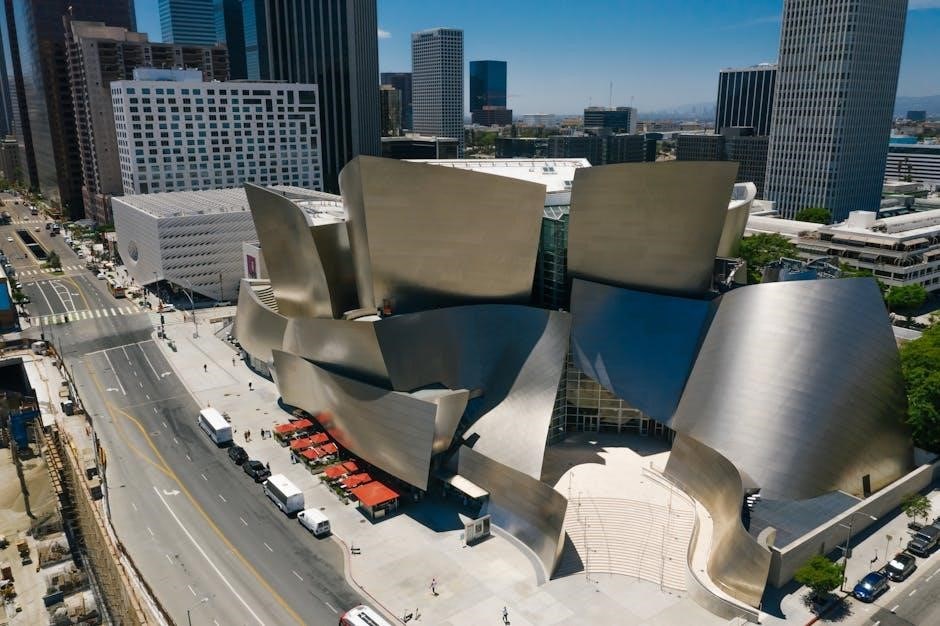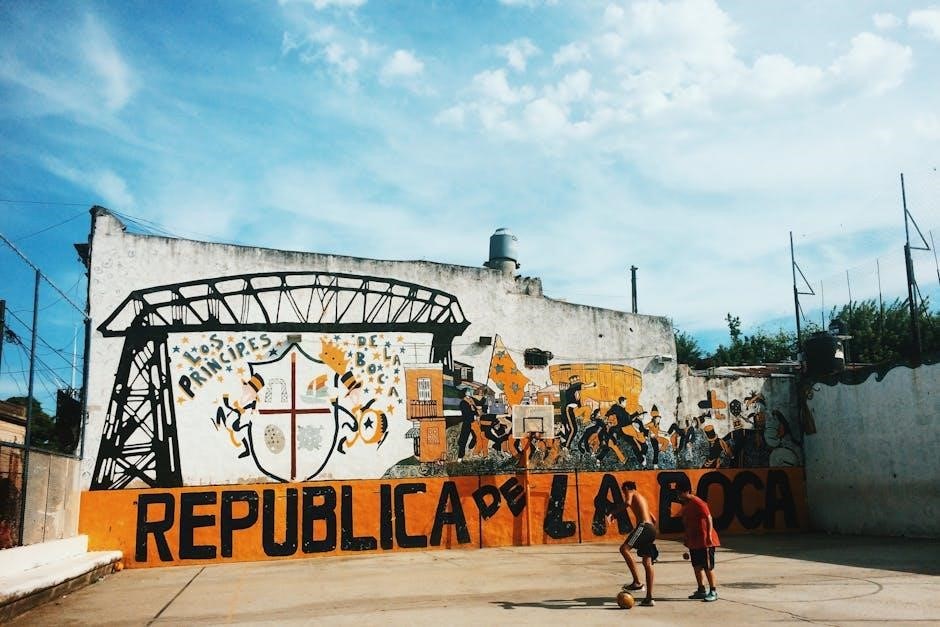La Noche Boca Arriba PDF: A Comprehensive Guide
This guide provides an in-depth exploration of Julio Cortázar’s La Noche Boca Arriba, offering insights into its surreal themes, historical context, and the fusion of reality and fantasy. The PDF version is widely available for download, featuring detailed analyses, cultural references, and study aids, making it an essential resource for both students and literature enthusiasts. Its accessibility ensures that readers can delve into Cortázar’s unique storytelling and the profound symbolism embedded within the narrative.
La Noche Boca Arriba (The Night Face Up) is a captivating short story by the renowned Argentine writer Julio Cortázar. First published in 1956, it is part of his collection Final del Juego (End of the Game); The narrative revolves around a young motorcyclist who, after a tragic accident, experiences a surreal fusion of his reality with the life of an Aztec warrior. This interplay between the modern world and ancient Mexico creates a unique and thought-provoking narrative structure.
Cortázar masterfully employs surrealism to blur the lines between past and present, reality and fantasy. The protagonist’s journey is both physical and metaphysical, exploring themes of identity, time, and the human condition. The story’s ability to merge seemingly unrelated events and characters has made it a standout piece in Cortázar’s oeuvre, attracting scholars and readers alike.

The PDF version of La Noche Boca Arriba is widely available, offering readers a convenient way to engage with the text. Its accessibility has made it a popular choice for academic studies and personal reading, further cementing its place in modern literary discourse.
Historical Context of the Story
La Noche Boca Arriba is deeply rooted in the historical and cultural fabric of Mesoamerica, particularly the Aztec civilization. The story references the rituals and beliefs of the Aztecs, such as human sacrifice and the reverence for gods like Huitzilopochtli. These elements are woven into the narrative to create a vivid contrast between the modern world of the motorcyclist and the ancient, mystical realm of the Aztec warrior.
Cortázar draws inspiration from historical accounts of Aztec society, blending factual details with fictional elements to craft a unique narrative. The story also reflects the broader cultural and historical tensions of 20th-century Argentina, where indigenous and European influences intersected. By juxtaposing these timelines, Cortázar explores themes of identity, time, and the interconnectedness of human experiences across eras.
The historical context enriches the story’s surrealism, allowing readers to appreciate the depth of Cortázar’s vision. The PDF version of the text often includes annotations and historical references, making it a valuable resource for understanding the narrative’s cultural and temporal layers.

Plot Summary and Key Events

Julio Cortázar’s La Noche Boca Arriba follows the story of a motorcyclist who suffers an accident and is taken to a pharmacy for treatment. As he lies injured, the narrative shifts to a surreal and dreamlike sequence where the motorcyclist imagines himself as an Aztec warrior about to be sacrificed. This duality of identities—modern man and ancient warrior—drives the plot, blending reality and fantasy seamlessly.
The motorcyclist’s accident serves as a catalyst for the narrative’s central events. His hallucinations, fueled by pain and confusion, create a vivid parallel world where the past and present collide. The story’s key events include the motorcyclist’s struggle to distinguish between his two realities, the impending sacrifice of the Aztec warrior, and the eventual merging of these identities into a single consciousness.

The plot’s climax occurs as the motorcyclist, now fully embodying the warrior, faces his fate. The story concludes with a poignant ambiguity, leaving readers to ponder the true nature of reality and identity. Cortázar’s masterful storytelling ensures that the PDF version of this tale remains a compelling and thought-provoking read.
Themes and Symbolism in the Narrative

Julio Cortázar’s La Noche Boca Arriba explores profound themes of identity, duality, and the interplay between reality and illusion. The narrative delves into the protagonist’s psychological state, symbolizing the struggle to reconcile modernity with ancient, primal instincts. The motorcyclist’s accident serves as a metaphor for the disruption of routine, plunging him into a surreal world where past and present collide.
Symbolism is pervasive throughout the story. The motorcyclist’s transformation into an Aztec warrior represents the clash between individual identity and collective history. The pharmacy, where the protagonist is taken, symbolizes a liminal space—a threshold between life and death, reality and fantasy. The recurring imagery of shadows, light, and fever underscores the fragility of human perception.
The story also explores existential themes, questioning the nature of time and consciousness. Cortázar’s use of juxtaposition—between the motorcyclist’s modern world and the warrior’s ancient rituals—highlights the timelessness of human struggles. These themes and symbols create a rich, layered narrative that invites readers to reflect on the complexities of existence.
The Role of Surrealism in the Story
Julio Cortázar’s La Noche Boca Arriba is deeply rooted in surrealist traditions, blending the conscious and subconscious to create a dreamlike narrative. The story’s central premise—a motorcyclist’s accident and his subsequent transformation into an Aztec warrior—embodies the surrealist concept of juxtaposing the rational with the irrational. The fluid transition between these two realities challenges the reader’s perception of time, space, and identity;
The narrative employs vivid, fantastical imagery, such as the motorcyclist’s delirious visions of hospitals and the warrior’s rituals, to explore the subconscious mind. Cortázar’s use of surrealism allows the protagonist to transcend his physical state, merging with a historical figure and blurring the boundaries between past and present. This technique not only heightens the emotional intensity of the story but also invites readers to question the nature of reality and identity.
Through its surrealist framework, La Noche Boca Arriba becomes a meditation on the human condition, where the boundaries between reality and fantasy dissolve, revealing deeper truths about existence;
Character Analysis: The Motociclista and the Guerrero Mexica
The motociclista and the guerrero mexica are two central figures in La Noche Boca Arriba, whose lives intersect through a surreal accident. The motorcyclist, a modern, urban character, crashes into a reality where he merges with an Aztec warrior preparing for sacrifice. This duality highlights Cortázar’s exploration of identity and time.
The motociclista represents contemporary life, with his accident symbolizing a break from routine. The guerrero mexica, rooted in ancient traditions, embodies sacrifice and duty. Their fusion challenges linear narrative, blending past and present. The motorcyclist’s delirium and the warrior’s rituals create a shared consciousness, exploring themes of existence and reality.
Through these characters, Cortázar examines the human condition, where individuals transcend time and culture. Their intertwined stories reflect the search for meaning beyond physical boundaries, making them symbols of universal human experiences. The motociclista and the guerrero mexica embody the story’s surreal essence, inviting readers to ponder identity and reality’s fluidity.
Cultural and Historical References in the Text
La Noche Boca Arriba is rich in cultural and historical references, particularly drawing from Aztec mythology and Mexican heritage. The character of the guerrero mexica (Mexican warrior) is deeply rooted in the traditions of the Aztec civilization, emphasizing themes of sacrifice and ritual. The narrative incorporates imagery of Aztec deities and symbols, such as the Chac Mool, which represents a fusion of ancient and modern worlds.
The story also references the historical context of Mexico, blending its pre-Columbian past with contemporary urban life. The motociclista’s accident and subsequent journey serve as a bridge between these eras, highlighting the enduring influence of cultural heritage. Cortázar’s use of these elements creates a layered narrative that explores identity and the intersection of past and present.

These references not only enrich the story but also provide a deeper understanding of the protagonist’s dual existence. The cultural and historical allusions are central to the narrative’s surrealism, offering readers a unique lens through which to view the blending of reality and fantasy.
The Fusion of Reality and Fantasy
In La Noche Boca Arriba, Julio Cortázar masterfully blends reality and fantasy, creating a surreal narrative that challenges the reader’s perception of time and space. The story follows a motorcyclist involved in an accident, whose consciousness shifts between the modern urban setting and an ancient, mystical realm. This duality is central to the narrative, as the protagonist’s identity becomes intertwined with that of a Mexican warrior (guerrero mexica) from a different era.
The fusion of these two realities is seamless, with vivid imagery and symbolic elements bridging the gap between the tangible world and the realm of dreams. Cortázar’s use of surrealism allows the reader to experience the fluid transition between these states, blurring the boundaries of what is real and what is imagined. This technique not only enhances the story’s depth but also explores themes of identity, time, and existence.
The interplay between reality and fantasy is a hallmark of Cortázar’s storytelling, leaving readers with a profound and lasting impression of the narrative’s complexity and beauty.
The Significance of the Title “La Noche Boca Arriba”
The title La Noche Boca Arriba (translated as “The Night Face Up”) holds profound symbolic significance, reflecting the narrative’s central themes of duality and transformation. The phrase “boca arriba” (face up) suggests vulnerability and exposure, as the protagonist lies helpless after the accident. This physical state mirrors his emotional and psychological journey, as he navigates between reality and fantasy.
The title also evokes the idea of surrender and the loss of control, emphasizing the protagonist’s powerlessness against fate. Additionally, “la noche” (the night) symbolizes the unknown, the subconscious, and the blending of time and space. Cortázar uses the title to hint at the story’s surreal nature, where the boundaries between waking life and dreams are blurred. Ultimately, the title encapsulates the essence of the narrative: a man suspended between two worlds, struggling to reconcile his identity and existence. This duality is a recurring motif in Cortázar’s work, making the title a fitting representation of the story’s complexity.
The Author’s Use of Imagery and Descriptions
Julio Cortázar’s masterful use of imagery and descriptive language in La Noche Boca Arriba creates a vivid and immersive narrative. The story is rich in sensory details, drawing readers into the protagonist’s surreal experience. For instance, the description of the accident and its aftermath is rendered with stark realism, while the fantastical elements, such as the fusion with the Guerrero Mexica, are depicted with a dreamlike precision. Cortázar employs metaphors and similes to blur the lines between reality and fantasy, crafting a world where the tangible and the abstract coexist. The imagery of the hospital, the motorcycle, and the Aztec warrior is particularly striking, evoking a sense of disorientation and wonder. Through these descriptions, Cortázar not only builds atmosphere but also deepens the psychological complexity of the protagonist. The text’s visual and symbolic richness invites readers to interpret the narrative on multiple levels, making it a hallmark of Cortázar’s storytelling style. His ability to balance concrete details with abstract concepts underscores the story’s themes of identity, time, and the human condition.
The PDF Version: Features and Accessibility

The PDF version of La Noche Boca Arriba is widely available for download, offering readers a convenient and accessible way to engage with Julio Cortázar’s work. The document is typically in Spanish, preserving the original language and stylistic nuances of the story. Many versions include features such as bookmarks for easy navigation, high-quality text, and OCR (Optical Character Recognition) for readability. The PDF is often accompanied by study guides, analyses, and educational resources, making it a valuable tool for students and scholars. Its digital format ensures compatibility with various devices, allowing readers to access the story on smartphones, tablets, and e-readers. Additionally, platforms like Scribd and the Internet Archive provide free or low-cost access, democratizing the availability of this literary masterpiece. The PDF’s portability and searchability enhance the reading experience, enabling users to highlight, annotate, and reference specific passages effortlessly. This accessibility has made the PDF a preferred choice for both casual readers and academic purposes.
Downloading and Reading the PDF
Downloading and reading the PDF of La Noche Boca Arriba is a straightforward process, with the document widely available across various platforms. Many websites, such as Scribd, the Internet Archive, and academic repositories, offer free or low-cost access to the PDF. Users can typically download the file in a matter of minutes, with options to save it directly to their devices or access it online. The PDF is often accompanied by additional materials, such as study guides or analyses, which can enhance the reading experience. Once downloaded, readers can easily navigate the text using features like bookmarks or search functions. The file is compatible with most e-readers, smartphones, and tablets, making it accessible on the go. For those who prefer not to download, many platforms allow in-browser reading, ensuring flexibility for all users. This ease of access has made the PDF a popular choice for both casual readers and scholars studying Cortázar’s work. The clear formatting and readability of the PDF ensure an immersive and engaging experience for all who dive into this surreal narrative.
Analysis of the Story’s Ending
The ending of La Noche Boca Arriba is a masterful conclusion to Cortázar’s surreal narrative, leaving readers with a profound sense of ambiguity and reflection. The story’s final moments blur the lines between reality and fantasy, as the motociclista and the Guerrero Mexica merge into a single consciousness. This fusion symbolizes the transcendence of time and identity, suggesting that the protagonist has reached a state of liberation from his physical and emotional pain. The ending is open to interpretation, inviting readers to ponder the nature of existence and the interconnectedness of human experiences. Cortázar’s use of imagery and symbolism in the closing scenes reinforces the theme of duality, where life and death, past and present, coexist in a seamless continuum. The story’s conclusion is both haunting and thought-provoking, leaving a lasting impression on the reader and cementing its place as a landmark of modern literature. The PDF version of the text preserves the original’s emotional and philosophical depth, ensuring that the ending’s impact remains unchanged for digital readers.
The Story’s Relevance in Modern Literature

La Noche Boca Arriba remains a cornerstone of modern literature, resonating with contemporary readers through its exploration of surrealism, identity, and the human condition. Cortázar’s unique narrative style, blending reality and fantasy, continues to influence writers and inspire new generations of literary enthusiasts. The story’s themes of duality, timelessness, and the interconnectedness of experiences are timeless, making it a subject of ongoing academic and cultural discussion. Its availability in PDF format has further amplified its reach, ensuring that Cortázar’s profound insights are accessible to a global audience. The narrative’s ability to transcend borders and generations underscores its relevance in modern literature, as it challenges readers to reflect on the complexities of existence. The fusion of philosophical depth and poetic prose in La Noche Boca Arriba solidifies its place as a seminal work in 20th-century literature, maintaining its significance in today’s literary landscape. The story’s enduring appeal lies in its universal themes and its ability to provoke thought, ensuring its continued influence in modern literary discourse.

Educational Resources and Study Guides
For educators and students, numerous educational resources and study guides are available to deepen the understanding of La Noche Boca Arriba. These materials, often distributed in PDF format, include detailed lesson plans, reading guides, and analysis exercises tailored for academic use. Platforms like Scribd and educational websites offer downloadable resources that explore themes, symbolism, and narrative techniques in Cortázar’s work. Many of these guides are designed to facilitate classroom discussions, providing prompts for essays, group activities, and critical thinking exercises. Additionally, some resources include historical context, cultural references, and biographical information about the author, enriching the learning experience. These study aids are particularly useful for Spanish language learners and literature students, helping them grasp the complexities of the story. Teachers can also find customizable materials to adapt to different learning levels, ensuring a comprehensive exploration of the text. The availability of these resources underscores the story’s educational value, making it a popular choice for literary studies worldwide.

